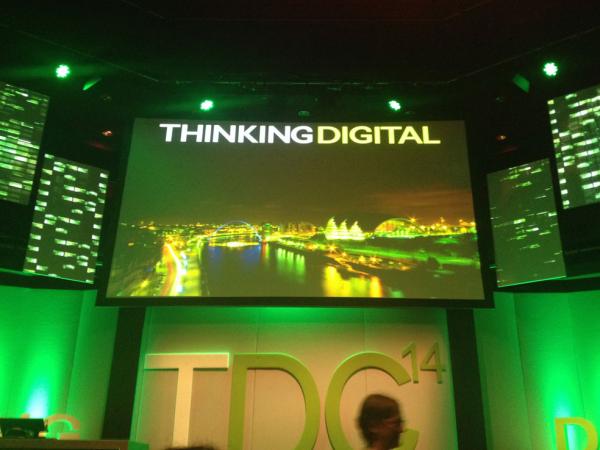There are some truly fantastic people working in the world of digital for museums, however it’s nice sometimes to get out of the arts and heritage bubble to learn some lessons from the digital community at large. There are ideas and developments circulating in the wider world that have huge implications for us and what we do. Not to mention some slightly scary cautionary tales.

After the first day of Thinking Digital 2014 at Sage Gateshead there was a lot of heated dinner table debate amongst members of the V&A Digital Media team about data mining, privacy and the implications of new technology on how we live our lives – both good and bad. For instance, does the ability to read text extra quickly, offered by Sprintz, provide an exciting opportunity for wearable technology, or a worrying tendency for shortened attention spans? And in turn, what does the rise of wearable tech mean for producers of digital content such as ourslelves? As Maik Mauer made clear, the definitions of every day activities such as reading are being dramatically reshaped by 21st century technology.
There was a lot of talk about data on day one – big, shared, open and mined. At first it seemed overwhelming, but it quickly became apparent that there were implications for the work we at the V&A Digital Media team do. For instance, a talk by Jeni Tennison on the possibilities of open and shared data has reminded me of the huge potential sitting in our Search the Collections database (museum collections mashup anyone?). And Peter Gregson‘s cello piece driven by genetic data was a nice reminder of the ways that digital and art can work together. Much like the fantastic projects our artists in residence, the T Shirt Issue are currently beavering away on.
Personalisation and discovery were big themes of the conference, and let’s face it, as a museum with a vast collection, we have a LOT of stuff to explore. Now, I’m a content editor, not a developer, I will let my far better qualified colleagues write about the latest thinking in discovery-versus search-engines, but what I *am* involved with is the stories our museum has to tell and how we help people find these stories. We’re already making tentative steps into a ‘discovery’ way of thinking – our (now award winning) digital map was designed as much for at-home sit-back browsing as it was for way finding.
Right now, we’re getting ready to release a new and improved version of our V&A blog. A big part of this is working out how people will navigate our blog posts and find what they want, or as Erin McKean pointed out, what they want, but don’t know to ask for. Now, we’re not in the land of discovery engines for our blogs or our website (yet!) but there are small changes we can make. On the train ride up to Newcastle, I was already pondering how careful and clever we need to be when creating and curating our blog metadata. We want people to rummage around and find the stuff they like. This could come down to something as seemingly simple as putting careful thought into how we tag our posts in the most relevant way, creating the most pertinent suggestions possible. In a world where people are growing weary of traditional searching, digital teams need to be more and more clever about how they share their content. We can’t expect our audiences to know specifically what they want. Some, of course will. For instance, a PHD student, studying maiolica will know exactly what they want to see in our collections. But what if you’re someone who loves colourful textiles, but has never heard of maiolica? You might love beautiful colours but don’t know to ask about ceramics. The question of how we best provide content to our audience is one that will go on and on, but it’s becoming increasingly clear that a traditional search box is not the answer.
But it’s also not as simple as just gathering as much data as possible and trying to give people what they want. Sometimes these new developments can be overwhelming and at times a little scary. Some of the things that are possible or imminently so seem like the stuff of sci fi – Blaise Aguera y Arcas’s explantion of AI led to more than a few Skynet tweets, and Aral Balkan left us delegates feeling like we lived in an Orwellian dystopia! There are so many fantastic new digital opportunities for museums, but we, like any organisation have an obligation to, in Erin McKean’s words, not be creepy.
We’ve got a long way to go, but we also have some brilliant stories to tell. The fun part for a content editor like me is helping our museum experts tell these stories and to work out how best to get this fantastic content to the people who will be inspired, educated and entertained by it.
And that was just day one!…



